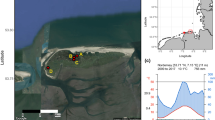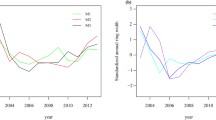Abstract
Key message
Radial growth of high-elevation shrubs shows the high sensitivity to climate in dry regions, providing new evidence for drought-mediated dynamics of alpine woody plants.
Abstract
In mountains, shrubs forming their uppermost distributional limits (shrubline) are highly sensitive to increasing cold limitations upwards. However, the constraints imposed by a shorter growing season due to lower temperatures upslope could interact with drought stress in mountainous regions. Here, we aim to investigate that question by comparing radial growth patterns of shrubs in wet (forest region of Nangqian County, BZ hereafter) vs. dry (forest region of Leiwuqi County, LWQ hereafter) regions located on the eastern Tibetan plateau. Considering the climate trend in this area towards warmer and drier conditions, we hypothesize that growth of high-elevation shrubs will be mainly limited by low summer temperatures under sufficient soil moisture. To test this hypothesis, we collected ring-width data from 123 alpine shrubs (Salix oritrepha Schneid.) along an altitudinal gradient from 4200 to 4600 m a.s.l. Dendroecological analyses showed that shrub growth was positively related to mean June or July temperature during the past decades in both wet (BZ) and dry (LWQ) regions regardless of site elevation. By contrast, correlations between shrub growth and seasonal precipitation were not significant. Shrub growth trends were positive before 2010 but turned negative afterwards. Overall, radial growth of shrubs along the altitudinal gradients up to the shrubline could shift from being temperature to moisture limited if warming-induced drought stress intensifies.




Similar content being viewed by others
Data availability
All the data analysed was included in our paper.
Code availability
This paper did not include codes.
References
Ackerman D, Griffin D, Hobbie SE, Finlay JC (2017) Arctic shrub growth trajectories differ across soil moisture levels. Glob Change Biol 23:4294–4302. https://doi.org/10.1111/gcb.13677
Au R, Tardif JC (2007) Allometric relationships and dendroecology of the dwarf shrub Dryas integrifolia near Churchill, subarctic Manitoba. Can J Bot 85:585–597. https://doi.org/10.1139/b07-055
Barry R (2008) Mountain weather and climate, 3rd edn. Cambridge University Press, Cambridge. https://doi.org/10.1017/CBO9780511754753
Blok D, Sass-Klaassen U, Schaepman-Strub G, Heijmans MMPD, Sauren P, Berendse F (2011) What are the main climate drivers for shrub growth in Northeastern Siberian tundra? Biogeosciences 8:1169–1179. https://doi.org/10.5194/bg-8-1169-2011
Boscutti F, Casolo V, Beraldo P, Braidot E, Zancani M, Rixen C (2018) Shrub growth and plant diversity along an elevation gradient: Evidence of indirect effects of climate on alpine ecosystems. PLoS ONE 13:e0196653. https://doi.org/10.1371/journal.pone.0196653
Buchwal A, Sullivan PF, Macias-Fauria M (2020) Divergence of Arctic shrub growth associated with sea ice decline. PNAS 117:33334–33344. https://doi.org/10.1073/pnas.2013311117
Christiansen CT, Lafreniere MJ, Henry GHR, Grogan P (2018) Long-term deepened snow promotes tundra evergreen shrub growth and summertime ecosystem net CO2 gain but reduces soil carbon and nutrient pools. Glob Change Biol 24:3508–3525. https://doi.org/10.1111/gcb.14084
Cook ER (1985) A time-series analysis approach to tree ring standardization. Ph.D. Thesis, University of Arizona, Tucson
Cook ER, Kairiukstis LA (2013) Methods of dendrochronology: applications in the environmental sciences. Springer Science & Business Media, Berlin
Crawley MJ (2007) The R book. John Wiley and Sons, Chichester, UK
Di Filippo A, Biondi F, Čufar K, De Luis M, Grabner M, Maugeri M, Presutti Saba E, Schirone B, Piovesan G (2007) Bioclimatology of beech (Fagus sylvatica L.) in the Eastern Alps: spatial and altitudinal climatic signals identified through a tree-ring network. J Biogeogr 34:1873–1892. https://doi.org/10.1111/j.1365-2699.2007.01747.x
Ding A, Xiao S, Peng X, Tian Q, Han C (2021) Shrub-rings used to reconstruct drought history of the central Alxa desert, northwest China. Int J Climatol. https://doi.org/10.1002/joc.7108
Ellison SBZ, Sullivan PF, Cahoon SMP, Hewitt RE (2019) Poor nutrition as a potential cause of divergent tree growth near the Arctic treeline in northern Alaska. Ecology 100:e02878. https://doi.org/10.1002/ecy.2878
Elmendorf SC, Henry GHR, Hollister RD et al (2012) Plot-scale evidence of tundra vegetation change and links to recent summer warming. Nat Clim Change 2:453–457. https://doi.org/10.1038/nclimate1465
Fang J, Wang Z, Tang Z (2011) Atlas of woody plants in China: distribution and climate. Springer, Berlin
Gaire NP, Fan ZX, Brauning A, Panthi S, Rana P, Shrestha A, Bhuju DR (2020) Abies spectabilis shows stable growth relations to temperature, but changing response to moisture conditions along an elevation gradient in the central Himalaya. Dendrochronologia 60:12. https://doi.org/10.1016/j.dendro.2020.125675
Gamm CM, Sullivan PF, Buchwal A, Dial RJ, Young AB, Watts DA, Cahoon SMP, Welker JM, Post E (2018) Declining growth of deciduous shrubs in the warming climate of continental western Greenland. J Ecol 106:640–654. https://doi.org/10.1111/1365-2745.12882
Gazol A, Camarero JJ (2012) Mediterranean dwarf shrubs and coexisting trees present different radial-growth synchronies and responses to climate. Plant Ecol 213:1687–1698. https://doi.org/10.1007/s11258-012-0124-3
Hallinger M, Manthey M, Wilmking M (2010) Establishing a missing link: warm summers and winter snow cover promote shrub expansion into alpine tundra in Scandinavia. New Phytol 186:890–899. https://doi.org/10.1111/j.1469-8137.2010.03223.x
HilleRisLambers J, Harsch MA, Ettinger AK, Ford KR, Theobald EJ (2013) How will biotic interactions influence climate change-induced range shifts? Ann NY Acad Sci 1297:112–125. https://doi.org/10.1111/nyas.12182
Holmes RL (1983) Computer-assisted quality control in tree-ring dating and measurement. Tree-Ring Bull 43:69–75
Knapp AK, Briggs JM, Collins SL, Archer SR, Bret-Harte MS, Ewers BE, Peters DP, Young DR, Shaver GR, Pendall E, Cleary MB (2008) Shrub encroachment in North American grasslands: shifts in growth form dominance rapidly alters control of ecosystem carbon inputs. Glob Change Biol 14:615–623. https://doi.org/10.1111/j.1365-2486.2007.01512.x
Körner C (2003) Alpine plant life: functional plant ecology of high mountain ecosystems. Springer, Berlin
Körner C (2007) The use of “altitude” in ecological research. Trends Ecol Evol 22:569–574. https://doi.org/10.1016/j.tree.2007.09.006
Li X, Rossi S, Liang E, Camarero JJ (2016) Temperature thresholds for the onset of xylogenesis in alpine shrubs on the Tibetan Plateau. Trees 30:2091–2099. https://doi.org/10.1007/s00468-016-1436-z
Li Z, Liu G, Fu B, Zhang Q, Ma K, Pederson N (2013) The growth-ring variations of alpine shrub Rhododendron przewalskii reflect regional climate signals in the alpine environment of Miyaluo Town in Western Sichuan Province, China. Acta Ecol Sin 33:23–31. https://doi.org/10.1016/j.chnaes.2012.12.004
Liang E, Eckstein D (2009) Dendrochronological potential of the alpine shrub Rhododendron nivale on the south-eastern Tibetan Plateau. Ann Bot 104:665–670. https://doi.org/10.1093/aob/mcp158
Liang E, Lu X, Ren P, Li X, Zhu L, Eckstein D (2012) Annual increments of juniper dwarf shrubs above the treeline on the central Tibetan Plateau: a useful climatic proxy. Ann Bot 109:721–728. https://doi.org/10.1093/aob/mcr315
Liang E, Shao X, Xu Y (2009) Tree-ring evidence of recent abnormal warming on the southeast Tibetan Plateau. Theor Appl Climatol 98:9–18. https://doi.org/10.1007/s00704-008-0085-6
Liang E, Wang Y, Xu Y, Liu B, Shao X (2010) Growth variation in Abies georgei var. smithii along altitudinal gradients in the Sygera Mountains, southeastern Tibetan Plateau. Trees 24:363–373. https://doi.org/10.1007/s00468-009-0406-0
Lu X, Camarero JJ, Wang Y, Liang E, Eckstein D (2015) Up to 400-year-old Rhododendron shrubs on the southeastern Tibetan Plateau: prospects for shrub-based dendrochronology. Boreas 44:760–768. https://doi.org/10.1111/bor.12122
Lu X, Huang R, Wang Y, Sigdel SR, Dawadi B, Liang E, Camarero JJ (2016) Summer temperature drives radial growth of alpine shrub willows on the northeastern Tibetan Plateau. Arct Antarct Alp Res 48:461–468. https://doi.org/10.1657/aaar0015-069
Lu X, Liang E, Camarero JJ, Ellison AM (2021) An unusually high shrubline on the Tibetan Plateau. Ecology. https://doi.org/10.1002/ecy.3310
Lu X, Sigdel SR, Dawadi B, Wang Y (2019) Climate response of Salix oritrepha growth along a latitudinal gradient on the northeastern Tibetan Plateau. Dendrobiology 81:14–21. https://doi.org/10.12657/denbio.081.002
Martin AC, Jeffers ES, Petrokofsky G, Myers-Smith I, Macias-Fauria M (2017) Shrub growth and expansion in the Arctic tundra: an assessment of controlling factors using an evidence-based approach. Environ Res Lett 12:085007. https://doi.org/10.1088/1748-9326/aa7989
Massaccesi G, Roig FA, Pastur GJM, Barrera MD (2008) Growth patterns of Nothofagus pumilio trees along altitudinal gradients in Tierra del Fuego, Argentina. Trees 22:245–255. https://doi.org/10.1007/s00468-007-0181-8
Miehe G, Miehe S, Vogel J, Co S, Duo L (2007) Highest treeline in the northern hemisphere found in southern Tibet. Mt Res Dev 27:169–173. https://doi.org/10.1659/mrd.0792
Mou Y, Fang O, Cheng X, Qiu H (2019) Recent tree growth decline unprecedented over the last four centuries in a Tibetan juniper forest. J for Res 30:1429–1436. https://doi.org/10.1007/s11676-018-0856-6
Mu Y, Zhang Q, Fang O, Lyu L, Cherubini P (2021) Pervasive tree-growth reduction in Tibetan juniper forests. For Ecol Manag 480:6. https://doi.org/10.1016/j.foreco.2020.118642
Myers-Smith IH, Forbes BC, Wilmking M et al (2011) Shrub expansion in tundra ecosystems: dynamics, impacts and research priorities. Environ Res Lett 6:15. https://doi.org/10.1088/1748-9326/6/4/045509
Panthi S, Fan ZX, Brauning A (2021) Ring widths of Rhododendron shrubs reveal a persistent winter warming in the central Himalaya. Dendrochronologia 65:11. https://doi.org/10.1016/j.dendro.2020.125799
Pearson RG, Phillips SJ, Loranty MM, Beck PSA, Damoulas T, Knight SJ, Goetz SJ (2013) Shifts in Arctic vegetation and associated feedbacks under climate change. Nat Clim Change 3:673–677. https://doi.org/10.1038/nclimate1858
Pellizzari E, Camarero JJ, Gazol A, Granda E, Shetti R, Wilmking M, Moiseev P, Pividori M, Carrer M (2017) Diverging shrub and tree growth from the Polar to the Mediterranean biomes across the European continent. Glob Change Biol 23:3169–3180. https://doi.org/10.1111/gcb.13577
Peng D, Wang Y, Xian G, Huete AR, Huang W, Shen M, Wang F, Yu L, Liu L, Xie Q (2021) Investigation of land surface phenology detections in shrublands using multiple scale satellite data. Remote Sens Environ 252:112133. https://doi.org/10.1016/j.rse.2020.112133
Pinheiro J, Bates D, DebRoy S, Sarkar D, Heisterkamp S R (2020) R Core Team_nlme: Linear and Nonlinear Mixed Effects Models. R Package Version 3.1-151
Post E, Forchhammer MC, Bret-Harte MS, Callaghan TV, Christensen TR, Elberling B, Fox AD, Gilg O, Hik DS, Høye TT (2009) Ecological dynamics across the Arctic associated with recent climate change. Science 325:1355–1358. https://doi.org/10.1126/science.1173113
Rixen C, Schwoerer C, Wipf S (2010) Winter climate change at different temporal scales in Vaccinium myrtillus, an Arctic and alpine dwarf shrub. Polar Res 29:85–94. https://doi.org/10.1111/j.1751-8369.2010.00155.x
Rozas V, DeSoto L, Olano JM (2009) Sex-specific, age-dependent sensitivity of tree-ring growth to climate in the dioecious tree Juniperus thurifera. New Phytol 182:687–697. https://doi.org/10.1111/j.1469-8137.2009.02770.x
Schmidt NM, Baittinger C, Kollmann J, Forchhammer MC (2010) Consistent dendrochronological response of the dioecious Salix arctica to variation in local snow precipitation across gender and vegetation types. Arct Antarct Alp Res 42:471–475. https://doi.org/10.1657/1938-4246-42.4.471
Vicente-Serrano SM, Beguería S, López-Moreno JI (2010) A multiscalar drought index sensitive to global warming: the standardized precipitation evapotranspiration index. J Clim 23:1696–1718. https://doi.org/10.1175/2009jcli2909.1
Wagenmakers EJ (2003) Model selection and multimodel inference: a practical information-theoretic approach. J Math Psychol 47:580–586. https://doi.org/10.1016/s0022-2496(03)00064-6
Wang Y, Liang E, Ellison AM, Lu X, Camarero JJ (2015) Facilitation stabilizes moisture-controlled alpine juniper shrublines in the central Tibetan Plateau. Glob Planet Change 132:20–30. https://doi.org/10.1016/j.gloplacha.2015.06.007
Wu X, Guo W, Liu H, Li X, Peng C, Allen CD, Zhang C, Wang P, Pei T, Ma Y, Tian Y, Song Z, Zhu W, Wang Y, Li Z, Chen D (2019) Exposures to temperature beyond threshold disproportionately reduce vegetation growth in the northern hemisphere. Natl Sci Rev 6:786–795. https://doi.org/10.1093/nsr/nwy158
Xiao S, Xiao H, Kobayashi O, Liu P (2007) Dendroclimatological investigations of sea buckthorn (Hippophae rhamnoides) and reconstruction of the equilibrium line altitude of the July first glacier in the Western Qilian mountains, northwestern China. Tree-Ring Res 63:15–26. https://doi.org/10.3959/1536-1098-63.1.15
Zhao X, Wang Y, Zhang Q, Luo L (2015) Climatic characteristics of heavy precipitation events during summer half year over the Eastern Tibetan Plateau in recent 50 years. Arid Land Geogr 38:675–683. https://doi.org/10.13826/j.cnki.cn65-1103/x.2015.04.004
Funding
This study was funded by the National Natural Science Foundation of China (41771222), and the Second Tibetan Plateau Scientific Expedition and Research Programme (2019QZKK0301).
Author information
Authors and Affiliations
Corresponding author
Ethics declarations
Conflict of interest
All the authors declare no competing interest.
Additional information
Communicated by Arthur Gessler.
Publisher's Note
Springer Nature remains neutral with regard to jurisdictional claims in published maps and institutional affiliations.
Supplementary Information
Below is the link to the electronic supplementary material.
Rights and permissions
About this article
Cite this article
Han, Y., Wang, Y., Liu, B. et al. Moisture mediates temperature-growth couplings of high-elevation shrubs in the Tibetan plateau. Trees 36, 273–281 (2022). https://doi.org/10.1007/s00468-021-02204-w
Received:
Accepted:
Published:
Issue Date:
DOI: https://doi.org/10.1007/s00468-021-02204-w




